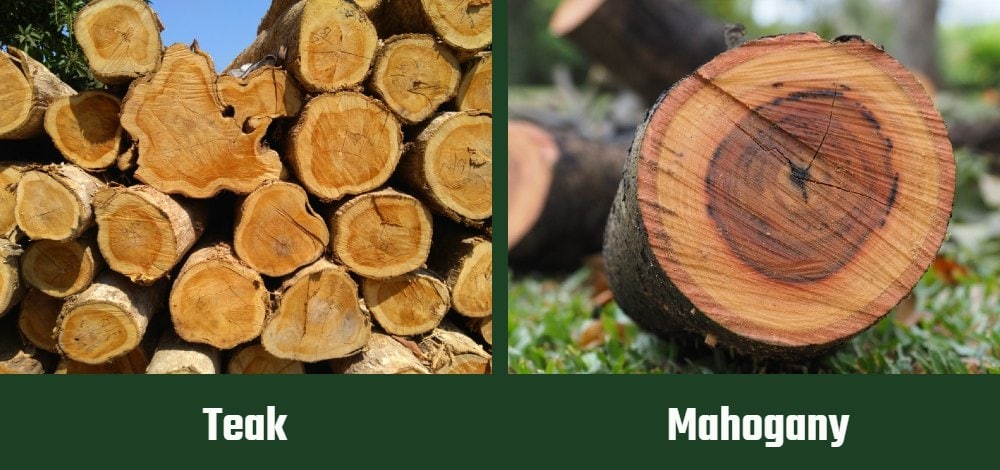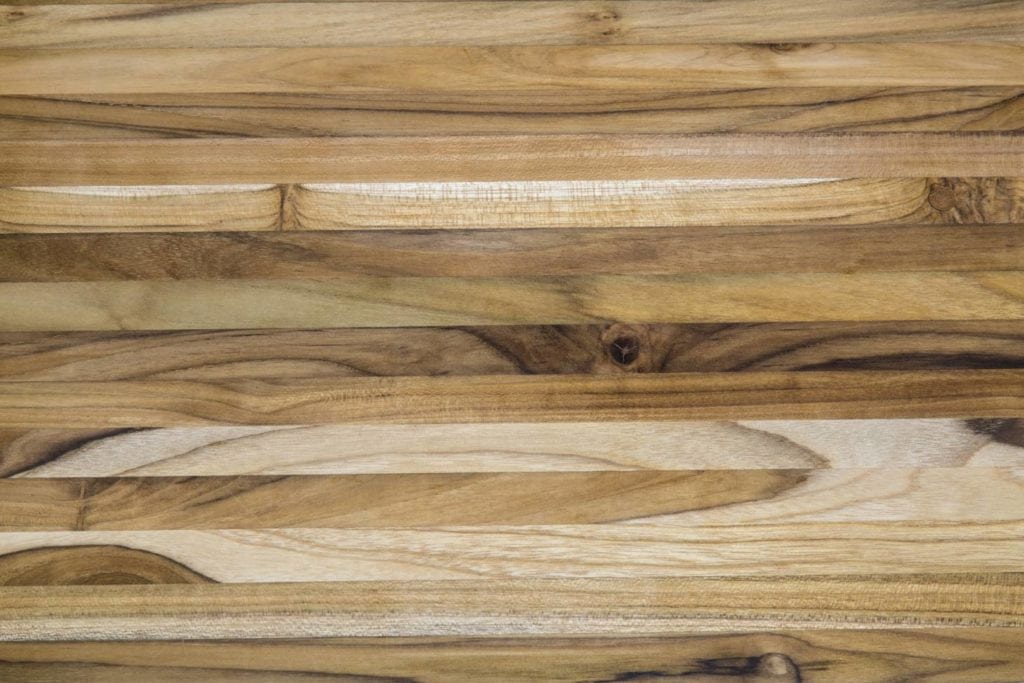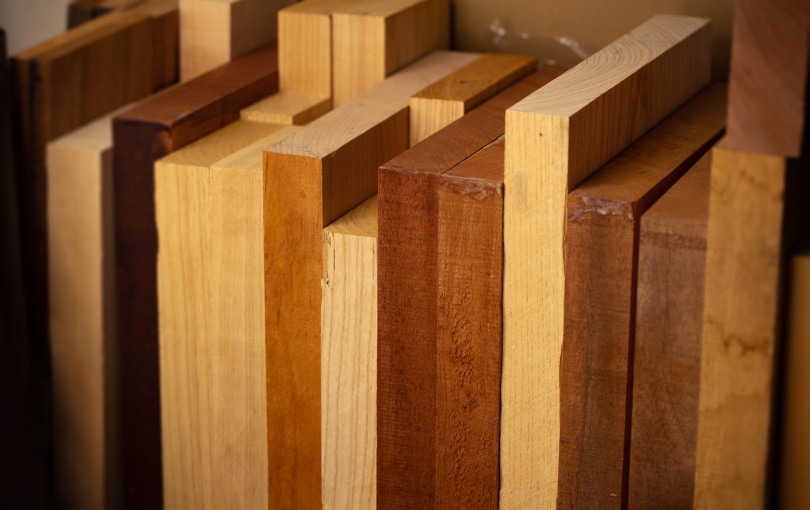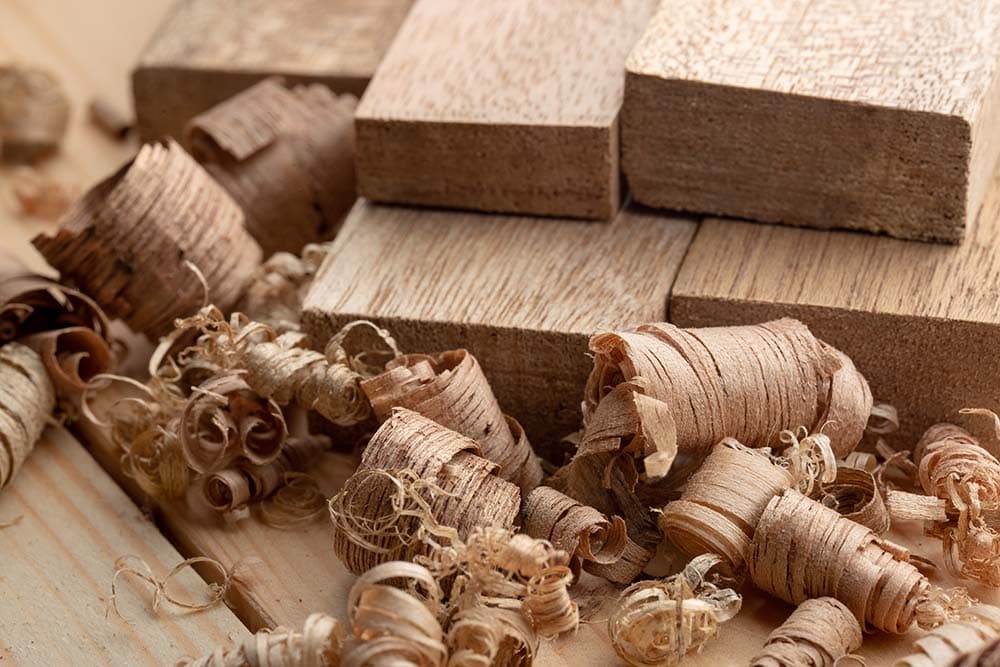Teak vs. Mahogany: Pros, Cons, Sustainability, & Differences
-
Codee Chessher
- Last updated:

Teak and mahogany are two of the more exotic woods out there, and both are prized by woodworkers. With very striking coloration and unique grain patterns, not to mention great durability, it can be hard to choose between the two for your next project. Let’s check out some more detailed info about each of them, their differences, and how to choose between them.

Overview of Teak
Teak has a long, storied history from its humble origins in Southeastern Asia. Historians think that teak has been used for over 2,000 centuries and was especially prized for shipbuilders because of its water-resistant properties. Teak was also used by native peoples to craft their homes, which helped fend off the wet weather. Today, it’s mostly used to make exotic-looking furniture. Teak furniture is highly moisture-resistant, which makes it ideal for outdoor furniture.
What makes teak unique is its natural oils that resist numerous adverse conditions, like moisture, insects, decay, and sunlight. One advantage of this potent oil is that teak doesn’t have to be finished, and in fact, varnish and other finishes will strip the teak of these oils.

Color
Fresh teak is a light golden color, and with sunlight and time, it will darken to a rich and dark golden brown. Depending on the genetics of the tree, some teak will darken more quickly than wood from other trees. You can use a finish to make teak retain its lighter color, but in doing so, it strips its valuable water-resistant oils.
Grain & Texture
Teak has a straight, irregular grain, which may be less visually appealing than more tight-grained woods. It feels oily to the touch and somewhat coarse, with a moderate luster from its oils.
Sustainability
Teak was once an endangered species because of rampant deforestation, but nowadays plantations focusing on sustainability make it more widely available.
- Highly water-resistant
- Resistant to pests
- Rot-resistant
- Extremely durable
- Very long-lasting
- Doesn’t require finishing
- Changes color in the sunlight, which may or may not be desirable
- Expensive
- Very dense, which makes it hard to work with
- Requires periodic maintenance to keep in good shape
- Its oily texture makes it hard to glue

Overview of Mahogany
Mahogany trees mostly hail from Mexico and South America, though variations exist worldwide. Mahogany is used to make furniture, ships, musical instruments, flooring, and more. Mahogany has a very tight, straight grain that makes it more visually appealing than other woods, including teak.
Mahogany provides a high-end, luxury look for a moderate price, though it’s among the softer hardwoods. Long, straight cuts of mahogany have a beautiful look that makes it suitable for door frames and other straight work patterns. Mahogany is very water resistant, but it’s susceptible to insects without finishing.

Color
Mahogany is a naturally dark-reddish color, but this can fade to a lighter brown with polishing and sunlight exposure. Some species of mahogany yield very light wood, like Australia’s native, the white mahogany.
Grain & Texture
Mahogany has a very tight, straight grain that gives it a dense, rich color. If you touch a piece of mahogany furniture, you’ll find that it’s typically slightly coarse unless it was polished and finished.
Sustainability
Mahogany is an endangered species because of its long growth time and heavy deforestation, which can harm indigenous peoples. Thankfully, African mahogany is more plentiful and makes for equally beautiful craftsmanship.
- Water-resistant
- Gorgeously rich dark-red color
- Straight, tight grain
- Decay-resistant
- Among the more affordable hardwoods
- Vulnerable to insects
- Less durable than other hardwoods
- Needs to be treated for maximum longevity
- Hard to work with
 What Are the Differences?
What Are the Differences?
Now that we’ve covered the basics about each wood, let’s check out how they fare head to head.
Color
Both mahogany and teak have very rich colors, though mahogany is lighter by default. At a glance, mahogany is more visually pleasing than teak, which has a more subtle beauty. Ultimately, the difference in color between the two comes down to personal preference.
Grain Patterns
Both teak and mahogany have a straight grain, but teak’s grain is more irregular. By contrast, mahogany’s grain is denser, with darker streaks here and there. In general, mahogany’s grain has more widespread appeal than teak’s.
Durability and Weather Resistance
Teak and mahogany are both durable. However, while mahogany furniture can last decades, teak can last a lifetime if taken care of. Mahogany is somewhat water-resistant, but it doesn’t hold a candle to teak, which is virtually waterproof.

Sustainability
Both teak and mahogany are considered endangered, which limits availability and raises prices. Mahogany is typically more widely available than teak, which usually has to be specially ordered.
Price
Mahogany costs about $27 per board foot, while teak is nearly double that at $47 per board foot. This makes mahogany better for large projects than teak, which is more suitable for special projects.
How to Choose the Right Wood for Your Project
For outdoor furniture, teak reigns supreme with unparalleled water resistance and durability. Mahogany makes beautiful, premium-looking furniture too, but its vulnerability to insects makes it a poor choice outdoors.
Mahogany is better for indoor furniture and all-purpose paneling or flooring because of its lower price, while teak is typically used for single pieces or accents. It would be wildly expensive to use a lot of teak in your home, while mahogany is more affordable for most people. Mahogany is also better for long, straight lines with its dense grain.
Both teak and mahogany are relatively hard to work with, which means you’ll need a great deal of experience with woodworking and ideally, familiarity with the wood you use.
Conclusion
Teak and mahogany are both high-end hardwoods, but teak is considerably more expensive. Teak is great for outdoor furniture because of its waterproof oil, while mahogany is great for indoor furniture and other all-purpose jobs.
- See also: 7 types of hacksaw frames and blades
Featured Image Credit: (L) K REEM STUDIO, Shutterstock | (R) Jason Gilkes, Shutterstock
Contents
 What Are the Differences?
What Are the Differences?